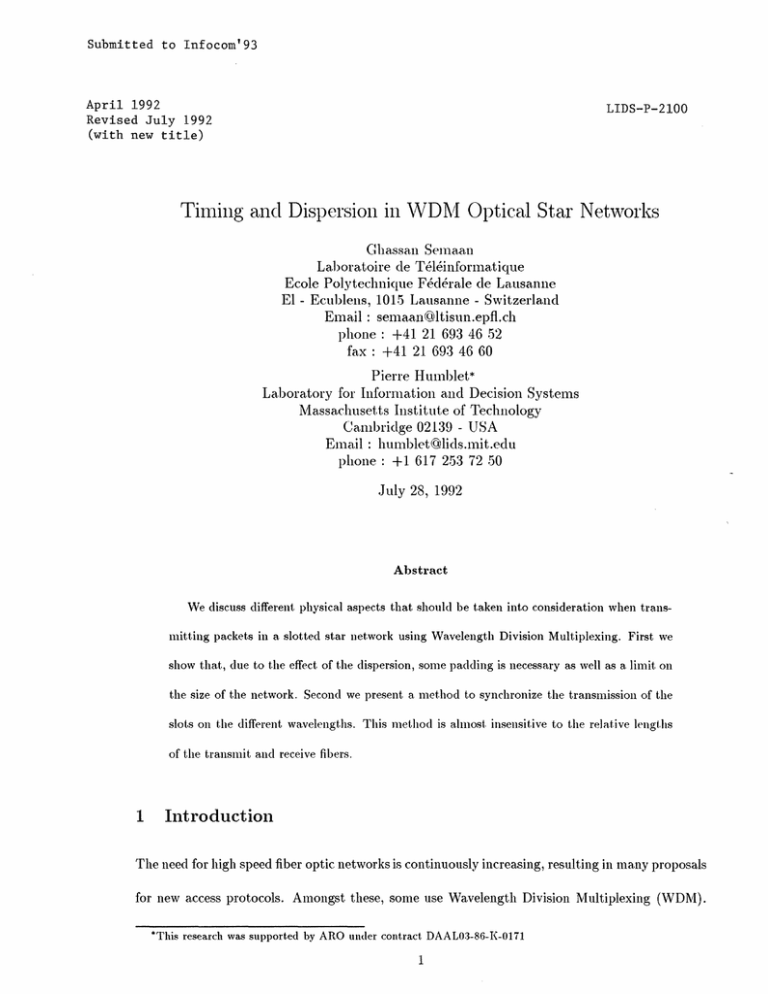Timing and Dispersion in WDM ...
advertisement

Submitted to Infocom'93
April 1992
Revised July 1992
(with new title)
LIDS-P-2100
Timing and Dispersion in WDM Optical Star Networks
Gha.ssan Selia-an
La.loratoire de T61kinformaticlue
Ecole Polytechnique Fed6rale de Lausanne
El - Ecublens, 1015 Lausanne - Switzerland
Email: semaan(.nltisun.epfl.
ch
phone: +41 21 693 46 52
fax: +41 21 693 46 60
Pierre Humblet*
Laboratory for Information and Decision Systems
Massachusetts Institute of Technology
Canlbridge 02139 - USA
Ellail: hulmblet alids.mlit .edu
phone: +1 617 253 72 50
July 28, 1992
Abstract
We discuss different physical aspects that should be taken into consideration when tra.ls-
mlitting packets in a slotted star network using Wavelength Division Multiplexing. First we
show that, due to the effect of the dispersion, some padding is necessary as well as a, limit on
the size of the network. Second we present a mlethod to synchronize the transmission of the
slots on the different wavelengths. This method is a.llllost insensitive to the relative lengths
of the transmit and receive fibers.
1
Introduction
The need for high speed fiber optic networks is continuously increasing, resulting in masny proposals
for new access protocols. Amongst these, some use Wavelength Division Multiplexing (WDM).
*This research was supported by ARO under contract DAAL03-86-K-0171
1
In WDM, data, is transmitted on different wavelengths, with each wavelength considered as an
independent channel. Channels are allocated to stations depending on their needs. Laboratory
prototypes using this technique have achieved a total throughput as high as hundreds of Gb/s
with each station's processing rate around 1 Gb/s [1].
Due to the attenuation in the couplers, the bus architecture is unsuitable for large networks
and the star architecture is assumed by almost all proposed WDM protocols. Some of the first
proposals using this architecture was made by Habbab in [3]. These proposals were based on
the well known ALOHA and CSMA protocols. Mehravari proposed an improved version of these
protocols in [4] , also based on ALOHA and CSMIA. But since then, Chen [5] and Sudhakar [6]
have proposed access schemes based on the slot switching principle.
With slot switching, data is sent in slots on each channel. The stations have to switch between
the different wavelengths to send or receive data. in predetermined slots. Two major problems arise
when the slots are transmitted in a. synchronous manner. The first one is the synchronization of
the network. When the slots are sent by different stations on the same wavelength, each station
must know when to start its transmission so that its slot will not overlap the slots of other stations
and generate a collision.
The second problem is due to dispersion. As slots a-re travelling on different wavelengths, they
will not be synchronous everywhere in the network. On some wavelengths the slots will travel
faster and reach the receivers before those travelling on the other wavelengths. This phenomenon
becomes a. problem when the stations have to switch from one wavelength to another.
For ease of comprehension, the dispersion is discussed first in section 2 where we show how to
minimize its effect. The synchronization is presented in section 3. We conclude in section 4.
2
2
Dispersion
The refractive index of the fiber varies with frequency. Hence the different frequencies dedicated to
the channels in WDM will propagate at different velocities. Dispersion, usually given in ps/'nm.km,
is caused by the wavelength dependence of the fiber refractive index and the associated differences
of the group velocity of light.
In the case of slot switching the dispersion plays a, very important role. Because of it, the slots
on the different wavelengths will travel at different velocities. Therefore, two slots transmitted
at the same time on two different wavelengths will reach a receiver at two different times. This
difference in time arrival, D, is equal to
D = lAxL
(1)
where M is the value of the dispersion in ps/nml.kim, AA, the difference between the two wavelengths
in nnm, and L is the distance travelled in km. In a network of 100 km, D can be as big as 400 ns
(M=20,AA=200) which is equivalent to 400 bits with a, 1 Gb/s rate.
When a station has to switch fromn Ai to Aj with l;xj > V' x , it will loose the beginning of the
slot on Aj. One solution to this problem is to add a certain amount of padding eqiual to D, a.t the
beginning (or the end) of the slot, in a. manner that when a. station has to switch between two
different wavelengths it will not loose any data. In the remaining of this section, we will show how
to minilllize this amount of padding and what is the minimum value.
In formula (1), L is the only variable. L is variable because the stations can be at different
positions from the hub. As we wish to have identical slots, the length of the padding should be
calculated for the maximum value of L, La,,,,.
Therefore, in order to have a, fixed slot structure
and to have a. limit on the value of D, there should be an ulplper bound, tfmla,, for the distance
3
of any station froml the hub. Otherwise, there will always be a position for the stations that will
result in a, bigger value of Lnmax. Our goal will be to find, with a fixed value of Hmax, the minimum
value of L,,,,a which minimizes D. We would like to focus on the difference between Hmax and
Lmax. Hmax is the maximum distance of a station (transmlitter or receiver) from the hub. Lmax
is the maximum distance travelled by the slots from the points where they are synchronous to the
switching points (i.e. transmitter and/or receiver). This will become clearer below.
The minimum value of La,,,,
depends on the nature of the transmitter and the receiver (tun-
able or fixed) used. Depending on the access protocol, there exist three different possibilities.
The protocol caln use either Fixed Transmitters(FT) and Tunable R.eceivers(TR.), or Fixed Receivers(FR.) and Tunable Transmitters(TT), or Tunable Translllitters and Tunable Receivers. The
solution using Fixed Transmitters and Fixed Receivers is not affected by the dispersion as only
one wavelength is transmlitted anld received by each device.
We will initially make two assumptions. The first one is that the network is synchronized. The
synchronization is discussed in detail in the next section. Therefore each station knows when it
should start transmitting so that its slots reach a. certain point in the network at a. certain time.
This point will be called the Referelce Point (RP). We define the R.P a.s the point, were the slots
traveling a.t different wavelengths arrive simultaneously if they were transnlitted at start of the
same slot. In other words, if we can have a silnultaneous view of all the wavelengths, the R.P is
the only point of the network where the slots on the different wavelengths are exactly aligned.
The second assumption is that the tuning is instantaneous. If it is not, an additional padding,
equal to the tuning delay, is necessary.
Let us first consider the case of a. protocol using a, FT and a. TR.. With this type of system,
each station has a. dedicated wavelength on which it transfers its data., and the receivers, based on
a given protocol, switch between the different wavelengths to read the data. sent to them. In this
4
case L is the distance between the RP and the receivers. In figure 1 we give an example of such a
network showing only two stations. In this example Al is dedicated to station 1 and A2 to station
2 with , h\1 > ,\2. The RP is chosen at the hub, which makes Lma,,
= Itnax. Tie translitter and
receiver of each station are represented by a vertical line showing their distance to the hub.
Stationl
Station2
Transmitter Transmitter
Hub=-RP]
Stationi
Receiver
Station2
Receiver
----
Due to the position of station 2 and to the velocity of A2, this station should start transmitting
its slots muIch sooner than station 1 so that they call reaclh the RP a.t the same time as those
of station 1. However the slots on Al will reach the stations before those on A2. If the size of
the padding incllultlded in thie beginning of each slot is sufficient, the sta.tions will )e able to switch
without losing data.
Depending on the position of the R.P, the length of the padding needed will be different. If
the RP was chosen at the farthest transmitter, the dispersion would be maximuml
In this case Lm,.
(cf. figure 2).
= 2 * Hmax, the distance between the farthest transmitter, which is the RP, and
the farthest receiver. Moving the R.P towards the receivers decreases Lmax until the R.P reaches
the mlid distance between Imnlj and Hm,,,,, where H,,, is the miinimuim distance from the hub at
which a receiver is allowed to be. When the R.P is at this point, the advance of the slots on A2
over those on A1 at H,,i, is the same as the advance of the slots on A1 over those on A2 at H,,,,.
Moving the R.P further will increase Lm,:a, which becomes the distance between the R.P and I,,in.
Therefore, the position of the R.P, tha.t requires the least padding, is the one at (Hmax - HImin)/ 2 .
The same reasoning can be made for the case of a TT and a FR.. In this case Hn,,i and Hma; x.
are respectively the minimum and maximum distances between the hub and the transmitters. It
can also be shown that the optimal position of the R.P is the one at the llid distance between
Hm
2 i, anld Hn7Lax.
In the case of a TT and a TR it can be seen that the optimal position of the RP is at the hub.
The padding should be able to compensate for the dispersion at the transmitter and the receiver.
In figure 2 we present the length of the padding needed as a function of the position of the R.P.
m
Here we consider a network with M=20 ps/nm.km, AA=200nln, 1Hmax = 50kn7 and II,,i = Oktm.
D[ns]
400- $
360
.0
x.
320
-
TT and FR
o° [
240200
F1T and TR
J' .
.
280
3 TT
and TR
..
160
,
120
80
0-
50 40 30 20
Transmitter
401
I
10
,
0
'
Position of the RP
10 20 30 40 50
Hub
[km]
Receiver
Figure 2: Padding needed versus the position of the R.P
6
3
Reference Time
In calculating the padding necessary to overcome the dispersion problem, we assumed that the
network was synchronized. In this section, we address how this can be achieved. Two points must
be satisfied: (i) a reference clock that gives the reference time must exist and (ii) the propagation
delay from the transmlitter to the RP, or from the R.P to the receiver for all frequencies used must
be known. We will consider initially an ideal system where all the values are known with no errors.
We will consider the errors later.
The equation that gives the difference in time arrival (1) can also be written as
D = AI'A A
(2)
with MA'= Mc/l.(A), where c is the speed of light in a, vacuum, n(A) is the group refractive index
of the fiber for the different wavelengths, and 6 is the time needed to travel the distance L. So if
we know the propagation delay 6i between two points on Ai, the propagation delay on Aj will be
j = 6-i+ Atax,\ijbi
(3)
For the reference clock, a. predetermined station sends regularly, on a. predetermined wa.velength, As, a. SYNC slot. Based on the time of arrival of the SYNC at their receivers, the stations
will be able to calculate when they should start their transmission;
We assume that each station i knows (figure 3):
1. 5.:p : the propagation delay from the center of the star to the RP on As (the wavelength
used by the SYNC); 6E c
is a. configuration value, known by all the stations. Its value can
be positive or negative depending on which side of the hub the R.P is.
7
2. ETR: the propagation delay on Ai from its transmitter to its receiver, i.e. across the star;
This value is measured on the wavelength Ai when the station is turned on; it can be done
by having the station send a slot to itself.
3. TR. : time of arrival of the SYNC a.t the receiver;
4. M': the dispersion;
and therefore can calculate Tj, the time for the start of the transmlission of its slots on Aj;
Transmitter (T)
Hub (C) RP(P)
TC
_
Receiver (R)
_8CRP
STR
Figure 3: Different delays between the transmitter and the receiver of a, station
We consider that (cf. figure 3 for the different delays used):
cC = 6aR
(4)
CR = 1 6 TR
(5)
and
6
with a + /3 = 1. Ideally a, and /3 should be 0.5, but as the transmlit and receive fibers are different,
this need not be so.
If a. station has to send its data in the N t h slot after the SYNC on the wavelength Aj, it should
8
start its transmission at Tj with
(6)
Tj = Tp - b6p + (N - 1) * SlotLength
where Tp is the tilme when the reference slot should be a.t the R.P. (6) ca.n be further developed in
Tj
=
TR- 6'R -
6bp +
(N - 1) *
SlotLength
TR -
6
PR - AlVAXi
=TR -
6
TR - M'('iAJxSPR +
TR -
6
TR - M'((6TR(/3\Ai, + a'Axj) -
=
6
PR - 6TP-
1'ijp
+ (N -1)
* SlotLength
xij6T'p) + (N - 1) * SlotLength
(7)
-\xjAbCP) + (N - 1) * ,SlotLength
With such Tj, station i will be able to tra.nsmit its slots on wavelength Aj without colliding
with the slots of other sta.tions.
The value of Tj is affected by some errors due to the asymmetric length of the tra~nsmit a.nd
receive fibers a.nd the va.ria.tion of the temperature. The asymmetric length affects especially a, a.nd
f3 which, instead of being exactly equal, becomes approximla.tively equal to 0.5. The tempera~ture
affects M' [9]. It should be noticed however, that Tj depends little on ao and /3 as these two
parameters a.re multiplied by the dispersion M' which greatly diminishes their effects. hi (8) we
give a.n a.pl)roxima.tion of the error on T where we considered tha.t the error on 6p, Ai,, T, and
TR
a.re negligible and consider only the errors A-I' and A/3 = -An,. Therefore
TR(/
i +s
A
)AAi
+
-A
From (8) we can see that each varia.tion of first multiplicant of the right term (
p))
(8)
+ ...) by
1% va.ries AT j by 6 us (which is equivalenlt to 6 bits at 1 Gb/s). To a-void that this variation
9
affect the transmission, ATj shoulld be calculated for max(4-4
+ ...) and added to the padding
N. Therefore the length of the padding becomes
N = D + AT
4
i
..
(9)
Conclusion
We have given a slot structure that can be used in a network using the slot switching principle
with WDM. We have shown that to each slot should be added a. padding with a
1on
negligible
length. A value of 200 bits (for a, rate of 1 Gb/s) is typical. Ilowever, the length of the padding is
independent of the size of the slots. Therefore the choice of long slots reduces the percentage of
bandwidth lost for padding. We introduced also the Reference Point and discussed the importance
of its position on the length of the padding. We showed tha.t if we want to have a, fixed structure
for the slots, a. limit on the size of the network is necessary. Finally, we gave a means for the
stations to synchronize the transmission of their slots on the different wavelengths. The method
presented does not require knowledge of the dista.nce from/to the hulb but only the round trip
delay. The error on the synchronizat.ion was considered and added to tile padding.
References
[1] C.A. Brackett. Dense Wavelength Division Multiplexing Networks: Principles anld Applications. IEEE Journal on Selected Areas in C'ommunications, 8(6):948-964, August 1990.
[2] P.S.Elenry. High Capacity Lightwave Local Area Network. IEEE Comm. Mag., 27(10):20-26,
October 1989.
10
[3] I.M. IIabbab, M. Kavehrad, C.E. Sundberg. Protocols for Very Iigh-Speed Optical Fiber
Local Area, Networks Using a Passive Star Topology. Journal of Lightwave Technology, LT5(12):1782-1793, December 1987.
[4] N. Mehravari.
Performance and Protocol Improvements for Very I-igh Speed Optical
Fiber Local Area Networks Using Passive Star Topology. Journal of Lightuwave Technology,
8(4):520-530, April 1990.
[5] M-S. Chen, N.R.. Dono, R. R.amaswanmi. A Media-Access Protocol for Packet-Switched Wavelength Division Multia-ccess Metropolitan Area Network. IEEE Journal on0Selected Areas in
Conmmunications, 8(6):1048-1056, August 1990.
[6] G.N.M. Sudhakar, N.D. Georganas, M. Kavehrad. Slotted Aloha and Reservation Aloha Protocols for Very High-Speed Optical Passive Star Topology. Journal of Lightwave Technology,
9(10):1411-1422, October 1991.
[7] B.J. Ainslie, C.R.. Day. A Review of Single Mode Fibers with Modified Dispersion Characteristics. Journal of Lighttwave Technology, LT-4(8):967-979, August 1986.
[8] T.D. Croft, J.E. Ritter, V.A. Bhagavatula. Low-Loss Dispersion-Shifted Single-Mode Fiber
Manufactured by The OVD Process.
Journal of Lightwave Technology, LT-3(5):931
-9314,
October 1985.
[9] N. Lagakos, J.A. Bucaro, J. Ja.rzunski. Temperature-induced optical phase shifts in fibers.
Applied Optics, 20(13):2305-2308, 1 July 1981.
[10] E. Miller, I. Kamlinow eds. Optical Fiber Teleco2mm2unications II. Academic Press, Inc. 1988.




